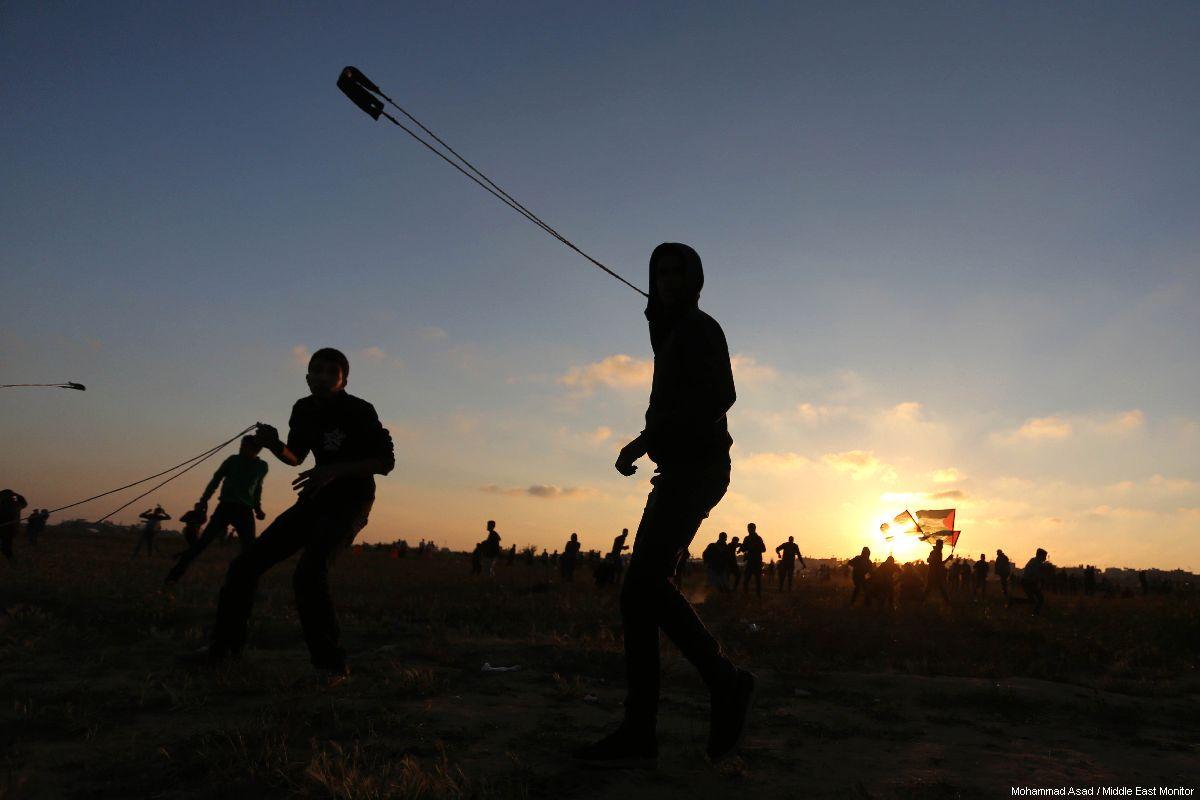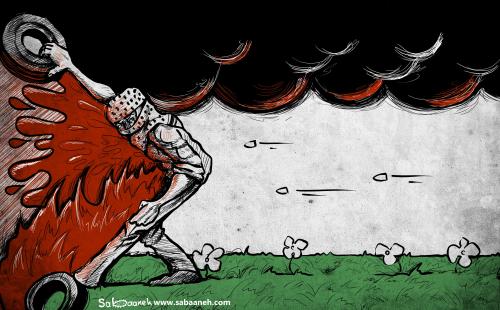What Have the Palestinians Gained from a Year of Protests along the Eastern Gaza Fence?
PALESTINE - ISRAEL, 1 Apr 2019
Motasem A Dalloul – Middle East Monitor

Palestinian protestors seen during a weekly “Great March of Return” demonstration near the Israel-Gaza border, on 22 March, 2019. [Mohammad Asad/Middle East Monitor]
29 Mar 2019 – On 30 March last year, the Palestinians in the Gaza Strip took part in the Great March of Return, an example of popular resistance initiated by activist Ahmad Abu Rtema and then adopted by the factions. They then established the National Committee for the Great March of Return and Breaking the Siege in order to run the protests. Protests have been held weekly ever since.
The Committee adopted the goals laid down by Abu Rtema, which remain an end to the 12-year-old Israeli-led siege imposed on the territory, and highlighting the right of Palestinian refugees to return to their homes and land inside what is now called Israel, from where their families were forced out by Zionist terrorists prior to the creation of the state in 1948.
Over the past year, Israeli occupation forces have killed 273 protesters and wounded more than 25,000 others. The so-called Israel Defence Forces also carried out several military operations while trying to suppress the protests, prompting the Palestinian resistance groups to respond by targeting Israeli cities and towns with homemade rockets. This, in turn, prompted urgent international mediation, with Egypt and the UN getting involved in an effort to calm the situation.

Palestinians along the Gaza-Israel border reaffirm the ‘Right of Return’ and get shot by IOF. Cartoon [Sabaaneh/MiddleEastMonitor]
Putting the bloodshed to one side, the Palestinian factions and many observers argue that the protests have achieved a lot on the political, national and humanitarian levels. They have, for example, put the Palestinian issue back to the top of the regional and international agendas. The protesters have also undermined the implementation of the US “deal of the century”, which has not yet found the quiet and stable environment necessary for it to be unveiled.
READ: One year following from the Gaza protests, almost 3,000 injured children required hospital treatment
Perhaps more than anything else, the protests have exposed the brutal reality of the Israeli occupation state, which claims to be a beacon of democratic values. Israel used lethal force against peaceful, unarmed protesters who, according to the UN and other international bodies, posed no danger whatsoever to its soldiers. The shocking death toll illustrated the fact that Israel has no respect for the right of the Palestinians to demonstrate in support of their legitimate right of return to their land.
In addition, the protests led to qualitative progress in the fractured relationship between the Palestinian resistance factions and a number of countries in the region, especially Egypt, which has been mediating a truce between the Palestinian resistance groups in Gaza and the Israeli government.
Palestinian resistance activists in the occupied West Bank have been inspired by what they have seen in Gaza, as have the millions of Palestinians in the refugee camps in neighbouring states and in the wider diaspora. They have seen their right of return being discussed at the highest levels.
Regarding the national gains, the Great March of Return protests are the largest ever popular resistance action. The fact that they are now coordinated by the unified National Committee is significant. This body, which includes rival factions, has had an impact on all national activities organised by any of the Palestinian factions in the Gaza Strip. This unity was reflected in the formation of the Joint Control Room for the military wings of the factions, which has been taking decisions regarding resistance efforts.
OPINION: Israel is targeting the Great March of Return anniversary with vile propaganda
On the humanitarian side, the protests have pushed Israel to ease its siege imposed on Gaza, even before any comprehensive understanding or truce has been agreed. In an effort to reduce or end the protests, Israel has allowed more electricity, paid for by Qatar, into the Gaza Strip; allowed Qatar to fund a job creation programme for 13,000 unemployed graduates and workers in the enclave; increased the fishing zone; allowed more exports and imports; afforded monthly cash payments to over 10,000 poor families; and opened the Rafah Crossing for people and trade. This has had a very positive impact on the devastated Gaza economy.
The Great March of Return protests have, therefore, achieved much for the Palestinians in the still besieged territory. Moreover, they have also shown that when they are united, the people are capable of great things, making everyone much more optimistic about achieving their national goals.
___________________________________________________
The author is MEMO’s correspondent in the Gaza Strip.
This work by Middle East Monitor is licensed under a Creative Commons Attribution-NonCommercial-ShareAlike 4.0 International License. If the image(s) bear our credit, this license also applies to them.
Go to Original – middleeastmonitor.com
Join the BDS-BOYCOTT, DIVESTMENT, SANCTIONS campaign to protest the Israeli barbaric siege of Gaza, illegal occupation of the Palestine nation’s territory, the apartheid wall, its inhuman and degrading treatment of the Palestinian people, and the more than 7,000 Palestinian men, women, elderly and children arbitrarily locked up in Israeli prisons.
DON’T BUY PRODUCTS WHOSE BARCODE STARTS WITH 729, which indicates that it is produced in Israel. DO YOUR PART! MAKE A DIFFERENCE!
7 2 9: BOYCOTT FOR JUSTICE!
DISCLAIMER: The statements, views and opinions expressed in pieces republished here are solely those of the authors and do not necessarily represent those of TMS. In accordance with title 17 U.S.C. section 107, this material is distributed without profit to those who have expressed a prior interest in receiving the included information for research and educational purposes. TMS has no affiliation whatsoever with the originator of this article nor is TMS endorsed or sponsored by the originator. “GO TO ORIGINAL” links are provided as a convenience to our readers and allow for verification of authenticity. However, as originating pages are often updated by their originating host sites, the versions posted may not match the versions our readers view when clicking the “GO TO ORIGINAL” links. This site contains copyrighted material the use of which has not always been specifically authorized by the copyright owner. We are making such material available in our efforts to advance understanding of environmental, political, human rights, economic, democracy, scientific, and social justice issues, etc. We believe this constitutes a ‘fair use’ of any such copyrighted material as provided for in section 107 of the US Copyright Law. In accordance with Title 17 U.S.C. Section 107, the material on this site is distributed without profit to those who have expressed a prior interest in receiving the included information for research and educational purposes. For more information go to: http://www.law.cornell.edu/uscode/17/107.shtml. If you wish to use copyrighted material from this site for purposes of your own that go beyond ‘fair use’, you must obtain permission from the copyright owner.
Read more
Click here to go to the current weekly digest or pick another article:
PALESTINE - ISRAEL:
